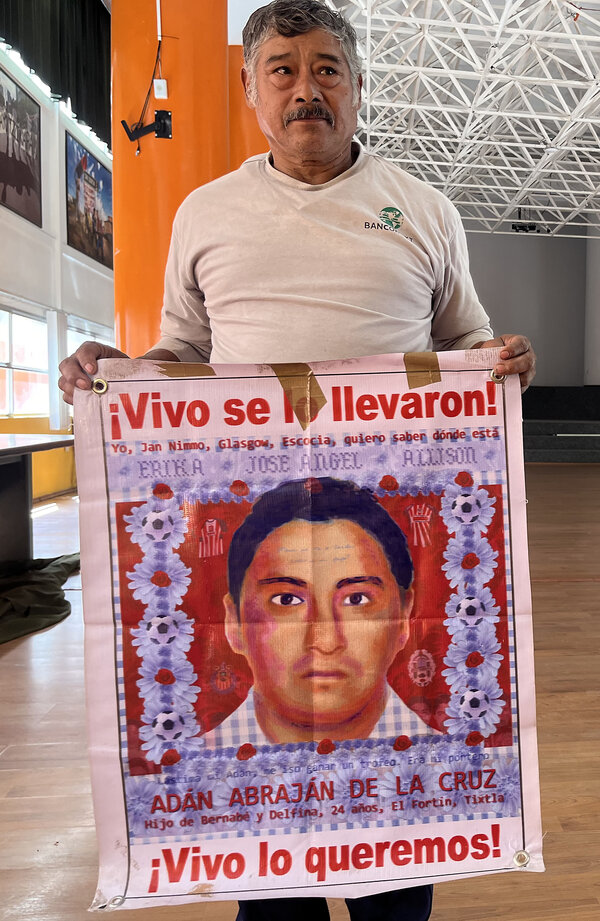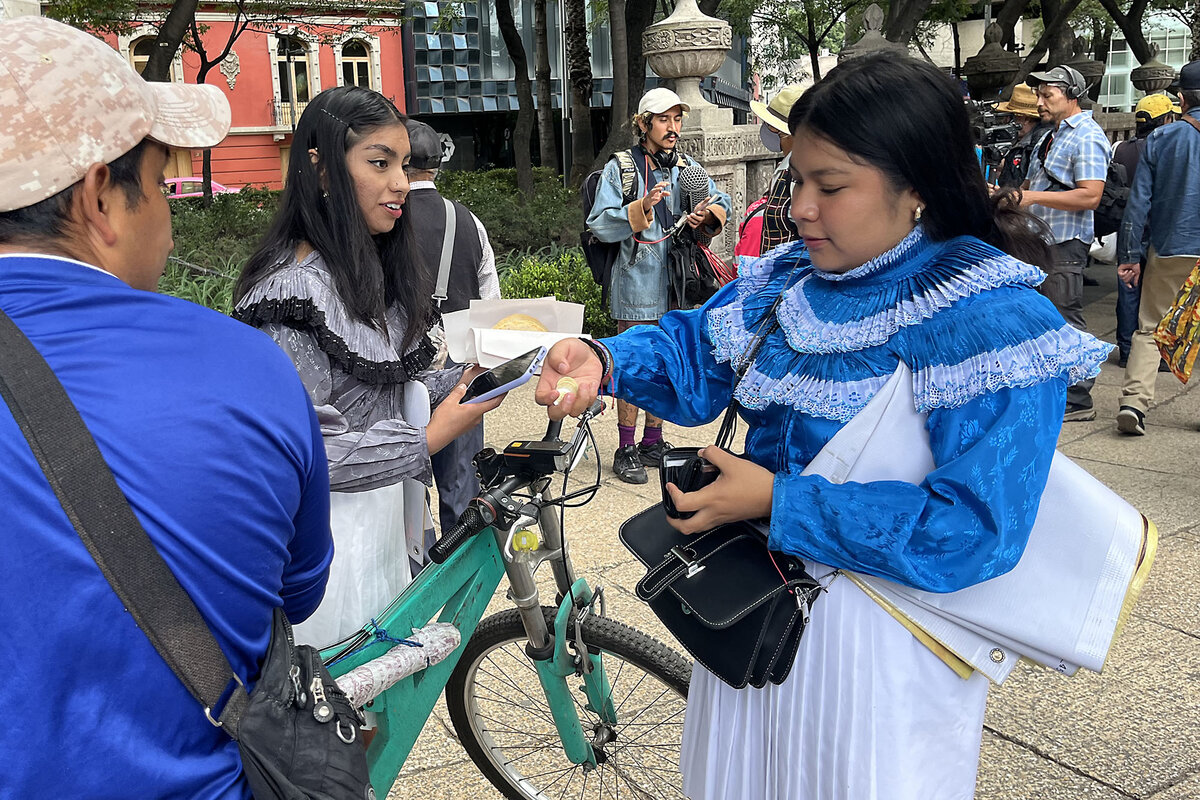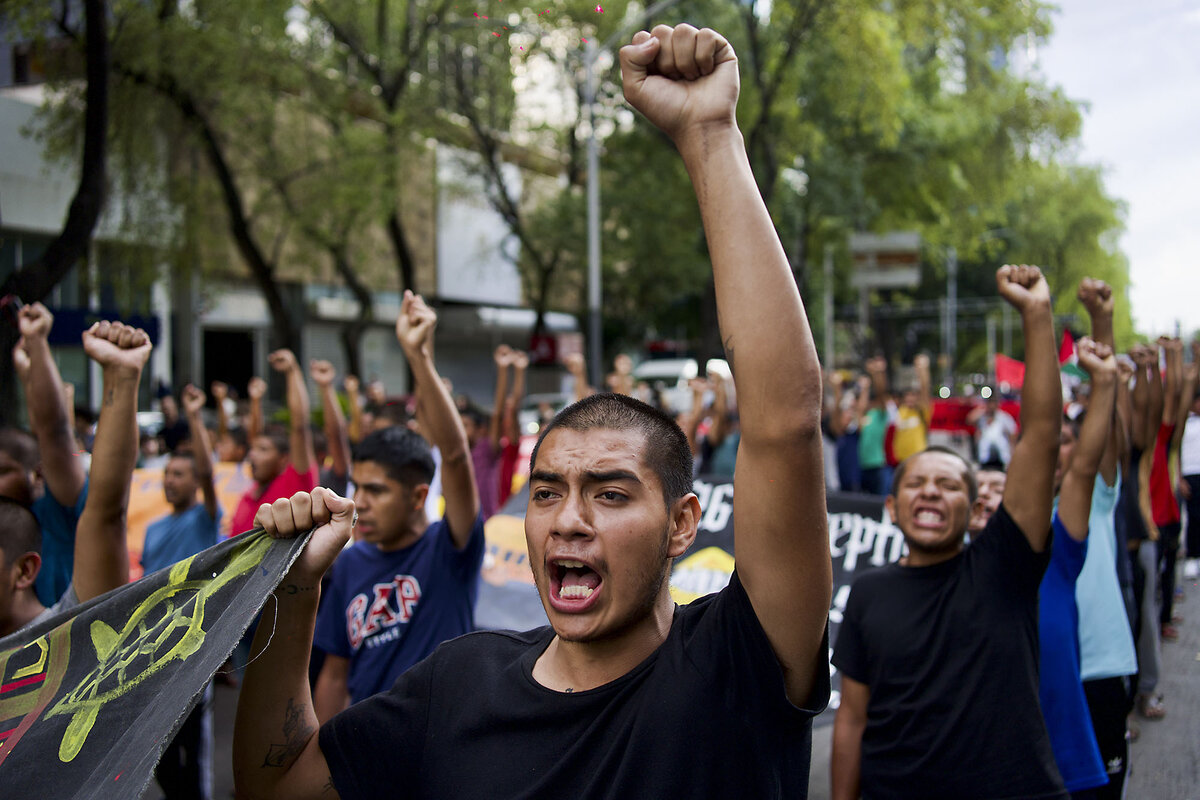Ten years after 43 students disappeared, Mexican parents still seek the truth
| Mexico City
Bernabé Abraham Gaspar’s son disappeared 10 years ago.
So as he has done on the 26th of nearly every month since, he adjusts his huarache sandals and finds his place on the main thoroughfare of Mexico City. In the shadow of the capital’s golden Angel of Independence, ominous gray clouds above Mr. Abraham split apart, letting the sun peek out as he and dozens of parents begin their long march, clutching pictures of their beloved sons, their faces frozen in time.
On Sept. 26, 2014, a group of 43 young, aspiring teachers was attacked and vanished in the southern Mexican state of Guerrero. In a country well known for its “disappeared,” whose numbers have grown along with record-high violence, this crime was so brazen it made the name of the remote, rural locale of Ayotzinapa, where the young men had been studying, globally recognizable.
Why We Wrote This
A story focused onProtests usually express opposition. But in Mexico, where parents of disappeared students have marched for 10 years, grief has fueled a social movement that is more powerful than dissent.
But as Mexico marks the 10th anniversary of a tragedy many hoped could change the nation – in how justice is meted out, how the government treats victims of violence, and how far violence is tolerated – the families of the students have little certainty about what unfolded that night and who, specifically, should be held responsible.
The Mexican state has doubled down to protect the armed forces and to sideline victims and their families, experts say, showing an unwillingness to get to the truth. But the tireless march of parents like Mr. Abraham has helped fuel a growing social movement powered not by political opposition, but by grief that has captured a society’s attention.
There have been “more expressions [of resistance] not only by the families of these students, but others whose loved ones have disappeared in this country,” says María Luisa Aguilar Rodríguez, a coordinator at the Center for Human Rights Miguel Agustín Pro Juárez A.C. (Centro Prodh), a human rights organization in the capital that helps the families of the 43. “They’re making clear to the world the failures of our institutions.”
As Mr. Abraham, whose son Adán was 24 years old when he disappeared, puts it, “If we stop coming [to protest], the government will say, ‘This doesn’t matter to us.’”
So he marches forward.
Establishing facts
The Raúl Isidro Burgos Rural Normal School in Ayotzinapa, where the young men were studying, is part of a network of teacher-training colleges that expanded after the Mexican Revolution in the early 1900s to bring education to rural areas. Over time, the schools became deeply involved with social issues such as land rights that have given them a reputation for radical activism.
One annual tradition at the Ayotzinapa teachers college was to commandeer buses to transport the students about 250 miles to Mexico City for an annual march commemorating a massacre of college students by the military in 1968.
But en route, police forced dozens of students off the buses they were riding. Six people, including three students, were killed in a confrontation that night, and 43 students vanished.
Soon after, the government of then-President Enrique Peña Nieto announced that the case had been solved and declared what it called the “historic truth.” It concluded that the men had been handed off by the police to local gang members who had taken them to a nearby trash dump, where their bodies were incinerated.
The parents never accepted that this was the truth, however, and began a four-year search for more answers, says Humberto Guerrero Rosales, the human rights program coordinator at Fundar, a Mexico City think tank that focuses on transparency.
And then, unexpectedly, came a ray of hope.
President Andrés Manuel López Obrador was elected in 2018, riding to power on his folksy, leftist rhetoric that for the first time in modern memory seemed to speak directly to Mexico’s long-ignored poor population. Early on, he set up a truth and justice commission for Ayotzinapa and appointed a special prosecutor for the case.
“My promise is not to fail the mothers [and] the fathers of the young people of Ayotzinapa, the people of Mexico,” said Mr. López Obrador in September 2018.
In 2022, the truth commission concluded what the families had believed from the start: The Ayotzinapa tragedy was a “crime of the state” involving police officers, government officials, and the military, along with a local drug trafficking gang. It debunked the story that the students’ bodies had been burned at a dump.
But by 2023, that sense of hope for the truth dimmed.
“The moment responsibility started to be assigned to the army, that’s where things started to fall apart,” says Mr. Guerrero, the human rights activist. The armed forces have played a central role in Mr. López Obrador’s administration, often carrying out traditionally civilian tasks such as building infrastructure, controlling migration, and even working in tourism.
“We have a president who basically denounced the work carried out by his close collaborators and closed ranks to defend the army and deny its participation,” Mr. Guerrero says. “The version of the narrative the government is now pushing has similarities to that initial ‘historic truth.’ The disappearances of the students was part of a local problem, specific to the state of Guerrero.”
Changing course
The government reverted to the previous administration’s attitude to the parents. They found themselves lumped into a broad group of actors President López Obrador felt were undermining his transformation of the country: the opposition.
The president “gave us hope that he would dedicate resources to this. That our pain wasn’t nothing. But then he did nothing,” says Calixta Valerio, whose son Mauricio Ortega Valerio was 18 years old when he disappeared alongside his classmates. He had grown up playing make-believe with his younger sisters, always taking the role of teacher, his mother recalls.
In December 2023, Mr. López Obrador changed the way in which the country’s disappeared were counted, reducing the number by 90% in one fell swoop, from 110,964 to 12,377. This was a slap in the face for those tirelessly searching for their missing loved ones, made worse when government agencies involved in the search for disappeared people saw their budgets cut.
“Disappearances” are not just a matter of widespread violence in certain parts of Mexico, says Ms. Aguilar from Centro Prodh. They happen “because none of those areas have installed the capabilities to carry out an investigation or criminal prosecution,” she says. “As long as no one investigates it, it continues.”
And the government has forgotten that the families of disappeared people in Mexico are not just another social movement, but victims, too, she adds.
“If the government understood them as victims, they would understand that for them it is impossible not to fight the state,” she says. “So, unlike other social movements, small steps or concessions won’t necessarily satisfy them. They aren’t the opposition; they are demanding support to find a loved one.”
Joining forces
Between 2007 and April 2023, the government identified more than 5,500 clandestine graves in Mexico, some of them holding multiple bodies. More than half of these mass burial sites are in just three states, including Guerrero.
The disappeared in Mexico tend to be young and poor, the same demographic around which Mr. López Obrador has centered his policies to end historic economic inequality.
Over the past 10 years, while the Ayotzinapa case has been drawn out on the public stage, families of other disappeared people have prominently organized in states across Mexico to take justice into their own hands. Groups like the “Searching Mothers of Sonora” and “The Network of Disappeared Persons in Tamaulipas” are proliferating, acting on anonymous tips and facing threats from criminal organizations in their hunt for answers that the authorities have not made a priority.
“I find hope in how victims and families are organizing,” says Mr. Guerrero. “Even victims from 50 years ago, victims of state terrorism in the 1970s, they still have the energy and imagination to create waves, to organize.”
Ayotzinapa family members met President-elect Claudia Sheinbaum Pardo in late July, but they have mixed feelings about what to expect from her once she takes office Oct. 1. Some say they worry her administration will offer more of the same, while others hold out hope she will recognize that Ayotzinapa created a clear “before and after” for disappearances in Mexico, and take concrete action.
It’s a pivot point that’s clearly marked on the streets. At the recent monthly Mexico City protest, the last before the 10th anniversary, scores of current students from the Ayotzinapa teachers college marched in tight rows, screaming so loudly their words were indecipherable.
Behind them followed a wave of teachers groups, Indigenous collectives, and a trio of drummers. Another group of demonstrators counted solemnly to 43 as they walked the route.
The parents and their supporters wove their way down the street through a roundabout dedicated to the nation’s disappeared, printouts of hundreds of faces glued to a temporary barricade. A half-mile later, they passed a roundabout dedicated to missing and murdered women.
“We first said we’ll go and march for eight days. Then 15 days, we’d protest,” says Macedonia Torres Romero, whose 18-year-old son José Luis Luna Torres was among the disappeared. “Now it’s 10 years we’ve been marching,” she says, holding up a banner with the boyish face of José Luis, who would be in his late 20s now.
“We’ll fight until the end. That’s what it means to be a parent,” she says, her T-shirt underlining the point: “Son, I’ll search until I find you.”












